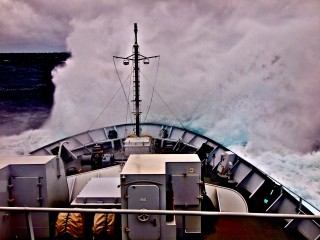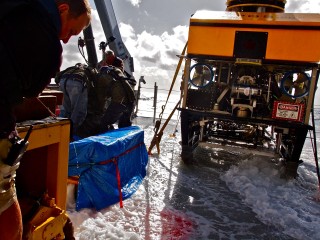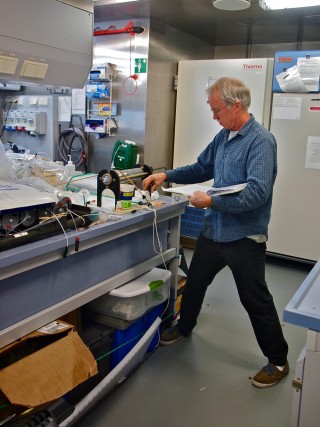Weather, weather, weather. It has been a major topic of discussion throughout this cruise. We had weather that prevented us from coming out here as early as planned, and then major weather that pretty much blew us out of the water. So where does this weather come from?

This time of year in the Northeast Pacific we can expect a few storms to brew up. Low pressure cells come off of Siberia and down from the Gulf of Alaska, bringing wind and waves along. These systems usually stick around for a day or two then pass. This is what happened at the beginning of the cruise.
However, what we are now experiencing is something the National Weather Service calls “extraordinary for late September.” This storm is more typical of what the area experiences in the winter months. What made it such a large event is that a typical low-pressure system got a major boost from moisture contributed by the system that is now Typhoon Pabuk, which was centered near Japan on Wednesday. Those typhoon remnants traveled all the way over the Pacific, through the Gulf of Alaska, and down to us, leaving a pretty incredible storm. We understand folks in Oregon and Washington State had an ugly weekend of rain and wind, but at least their houses weren’t rocking up, down, and sideways, and they didn’t fall out of their beds (I assume).
What It Means For Us

The team can only launch and recover ROPOS safely in seas less than 9 feet, preferably much less. The wave height is only one consideration, though. The period, or timing, of the swell, is also important, meaning how often the large waves pass under the ship. If the period is long, the ROV crew can predict and plan how they will handle the vehicle during the launch or recovery. If the period is too short, the seas become too jumbled and the team risks breaking the cable, and thus potentially losing the vehicle.
After we had to shut down ROV operations, all we really wanted to do was get horizontal during the storm. But, we still had samples to process and experiments to run, so we have been working carefully in the lab to the best of our abilities. We only broke one microbial incubation experiment, which I consider a victory.
Rough Life

Nobody has become terribly ill, and nobody has gotten hurt. We have spent a lot of time hanging out in the library, nibbling on pretzels and breadsticks, and riding this out as best we can. Sleeping is actually really hard because it’s challenging just to stay in your bunk. We use various strategies to wedge ourselves in, including stuffing under the outside edge of the mattress. Some have given up and tried to sleep on a couch mid-ship, where the motion is not as pronounced as it is when you are closer to the bow where our bunks are.
We have had a steady blow well above 40 knots for almost three days now, leaving a lot of messiness and large swells. We decided to stay out here, rather than go into port, because we hope to still be able to dive after things settle down. To stay out here, however, we had to make sure we were safe and, preferably, somewhat comfortable. The captain has chosen a path that keeps things as calm as possible.
If my stomach is any guide, we are still in pretty awful seas. But for the first time in 72 hours the winds are coming down and I am hopeful. For now we’ll continue wobbling about the ship, holding our trays very carefully at dinner, respecting Mother Nature in all her fury, and talking about the weather. At least the visiting dolphins outside seem to be having fun.

